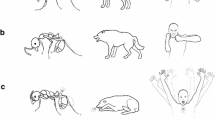Summary
Field studies (150 h) on pre-emergence, multiple-foundress colonies and laboratory observations (150 h) on post-emergence, single-foundress colonies revealed three distinct types of oscillatory movements in adultPolistes metricus. Two of these are analysed in this report. “Abdominal wagging” is a slow, horizontal abdominal oscillation performed by a female against the nest as she walks over brood cells. It is almost exclusively performed by queens in pre-emergence, foundress associations and more often by queens than workers in post-emergence colonies. In pre-emergence colonies abdominal wagging is done independently of the presence of other foundresses and first appears in colonies when broods contain third instar larvæ. We recorded no responses by other foundresses to abdominal wagging. In post-emergence colonies the performance of abdominal wagging is significantly correlated with both numbers of third larval instars and prey trips by workers.
“Lateral vibrations” consist of a female rapidly shaking her entire body in a horizontal plane against the top of the nest producing a short, loud burst of sound. Queens and subordinates exhibit this behavior equally often in early, pre-emergence colonies. Gynes frequently respond markedly to lateral vibrations by other foundresses with queens and subordinates exhibiting distinct responses. In post-emergence colonies queens laterally vibrate more often than workers and the number of vibrations by queens is highly correlated with the number of workers, adult females and larvæ at the colony.
We suggest that abdominal wagging principally functions in adult-brood interactions and lateral vibrations are involved in adult dominance communication.
Zusammenfassung
In jeweils 150 Beobachtungsstunden wurde das Verhalten vonPolistes metricus unter zwei verschiedenen Bedingungen beobachtet: erstens imk Freiland an Nestern mit mehreren Nestgründerinnen vor dem Schlüpfen der Arbeiterbrut, und zweitens im Labor an Nestern einer einzelnen Gründerin nach dem Schlüpfen der Arbeiterinnen. Dabei konnten drei Arten von oszillierenden Bewegungen unterschieden werden, von denen zwei in diesem Bericht analysiert werden. Die eine ist das “Schwänzeln”: während das Weibchen über die Brutzellen läuft, führt es langsame horizontale Schwänzelbewegungen mit dem Hinterleib aus, die gegen das Nest gerichtet sind. In Nestern mit mehreren Gründerinnen wird dieses Schwänzeln fast ausschliesslich von Königinnen durchgeführt, in den Nestern mit nur einer Gründerin zeigen es die Königinnen häufiger als die Arbeiterinnen. In den Nestern ohne Arbeiterinnen wird das Schwänzeln unabhängig von der Gegenwart anderer Gründerinnen ausgeführt, aber erst dann, wenn die Brut das dritte Larvenstadium erreicht hat. Reaktionen anderer Gründerinnen auf das Schwänzeln konnten nicht festgestellt werden. In den Laborkolonien, in denen schon Arbeiterinnen vorhanden sind, tritt das Schwänzeln umso häufiger auf, je mehr Larven des dritten Stadiums vorhanden sind und je mehr Beuteflüge die Arbeiterinnen unternehmen.
Als zweite Verhaltensweise wird das «seitliche Trommeln» analysiert: dabei schlägt ein Weibchen durch schnelle, waagrechte Vibrationen seines ganzen Körpers gegen die Oberseite des Nestes und erzeugt einen kurzen, lauten Schallstoss. In den Freilandkolonien zeigten die Königinnen und die subdominanten Gründerinnen dieses Verhalten gleich häuftig. Die Weibchen reagieren untereinander oft sehr deutlich auf das trommeln, wobei Königinnen und subdominante Gründerinnen in unterschiedlicher Weise antworten. In den Kolonien mit Arbeiterinnen trommeln die Königinnen weit häufiger als die Arbeiterinnen, und sie trommeln umso öfter, je mehr Arbeiterinnen, adulte Weibchen und Larven die Kolonie enthält.
Wir vermuten, dass das «Schwänzeln» hauptsächlich der Kommunikation zwischen Imagines und Larven dient, wohingegen das «Trommeln» an der Regelung der Rangordnung erwachsener Tiere beteiligt ist.
Similar content being viewed by others
References
Bohm M. F. K., 1972. — Reproduction inPolistes metricus. Ph.D. thesis, Dept. of Entomology, University of Kansas.
Dew H. E. — Division of labor among workers ofPolistes metricus (Hymenoptera: Vespidæ), Foraging activities. In prep.
Dropkin J. A., Gamboa G. J. — Physical comparisons of foundresses of the paper wasp,Polistes metricus. In prep.
Esch H., 1971. — Wagging movements in the waspPolistes versicolor vulgaris Beq.Zeitschr. Vergleich. Physiol., 72, 221–225.
Fluno J. A., 1972. — Grooming inPolistes exclamans (Viereck), a forerunner of communications in social hymenoptera.J. Wash. Acad. Sci., 62, 332–333.
Gamboa G. J., Heacock B. D., Wiltjer S. L., 1978. — Division of labor and subordinate longevity in foundress associations of the paper wasp,Polistes metricus (Hymenoptera: Vespidæ).J. Kans. Ent. Soc., 51, 343–352.
Gamboa G. J., Dropkin J. A., 1979. — Comparisons of behaviors in early vs. late foundress associations of the paper wasp,Polistes metricus (Hymenoptera: Vespidæ).Can. Ent., III, 919–926.
Gibo D. L., 1977. — A method for rearing various species of social wasps of the genusPolistes (Hymenoptera: Vespidæ) under controlled conditions.Can. Ent., 109, 1013–1015.
Hermann H. R., Dirks T. F., 1975. — Biology ofPolistes annularis. I. Spring behavior.Psyche, 82, 97–108.
Matsuura M., 1970. — Data for the nests of the giant paper-wasp,Polistes gigas Kirby, in Formosa with special consideration on colony size.The Life Study (Fukui),14, 35–40.
Morimoto R., 1961a. — On the dominance order inPolistes wasps. I. Studies on the social Hymenoptera of Japan. XII.Sci. Bull. Fac. Agric. Kyushu Univ., 18, 339–351.
Morimoto R., 1961b. — On the dominance order inPolistes wasps. II. Studies on the social Hymenoptera of Japan XIII.Sci. Bull. Fac. Agric. Kyushu Univ., 19, 1–17.
Pardi L., 1942. — Recherche sui Polistini. V. La pologinia iniziale diPolistes gallicus (L.).Bull. Ist. Ent. R. Univ. Bologna, 14, 1–106.
Pardi L., 1948. — Dominance order inPolistes wasps.Physiol. Zool., 21, 1–13.
Rau P., 1938. — Studies in the ecology and behavior ofPolistes wasps.Bull. Brooklyn Ent. Soc., 33, 224–235.
West Eberhard M. J., 1969. — The social biology of polistine wasps.Misc. Pub. Mus. Zool., Univ. Michigan,140, 1–101.
Author information
Authors and Affiliations
Rights and permissions
About this article
Cite this article
Gamboa, G.J., Dew, H.E. Intracolonial communication by body oscillations in the paper wasp,Polistes metricus . Ins. Soc 28, 13–26 (1981). https://doi.org/10.1007/BF02223618
Received:
Accepted:
Issue Date:
DOI: https://doi.org/10.1007/BF02223618




